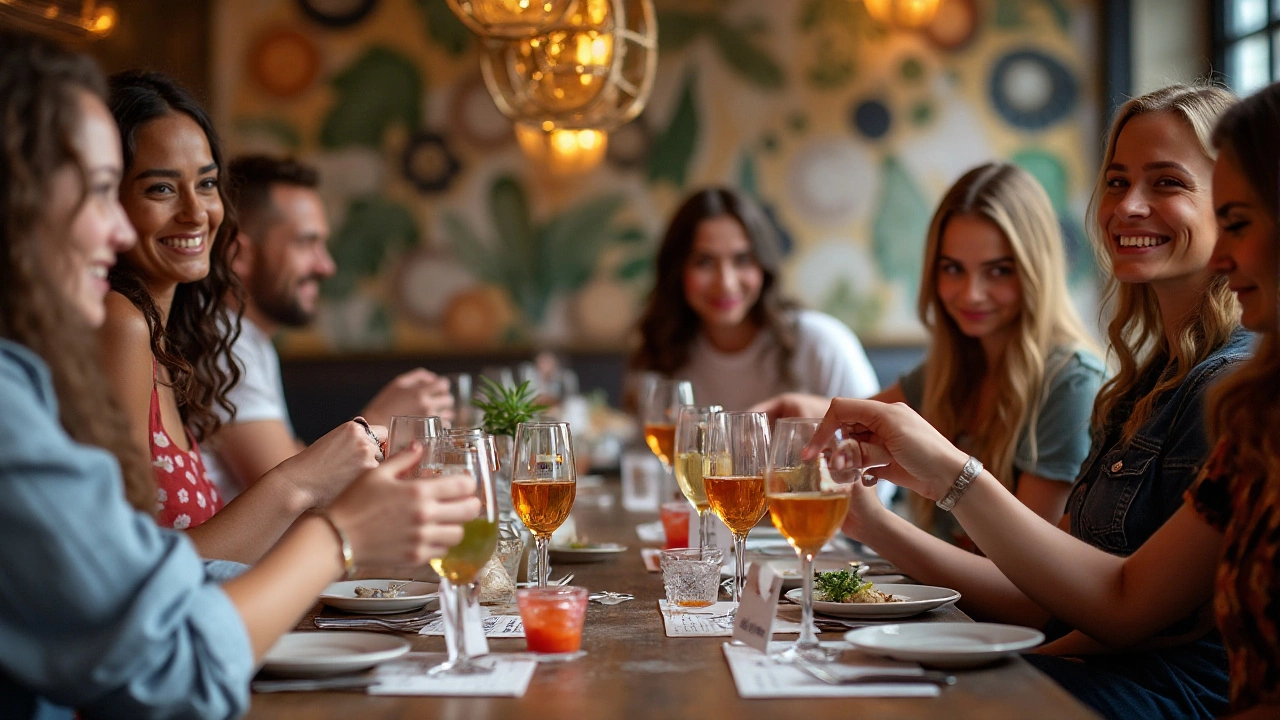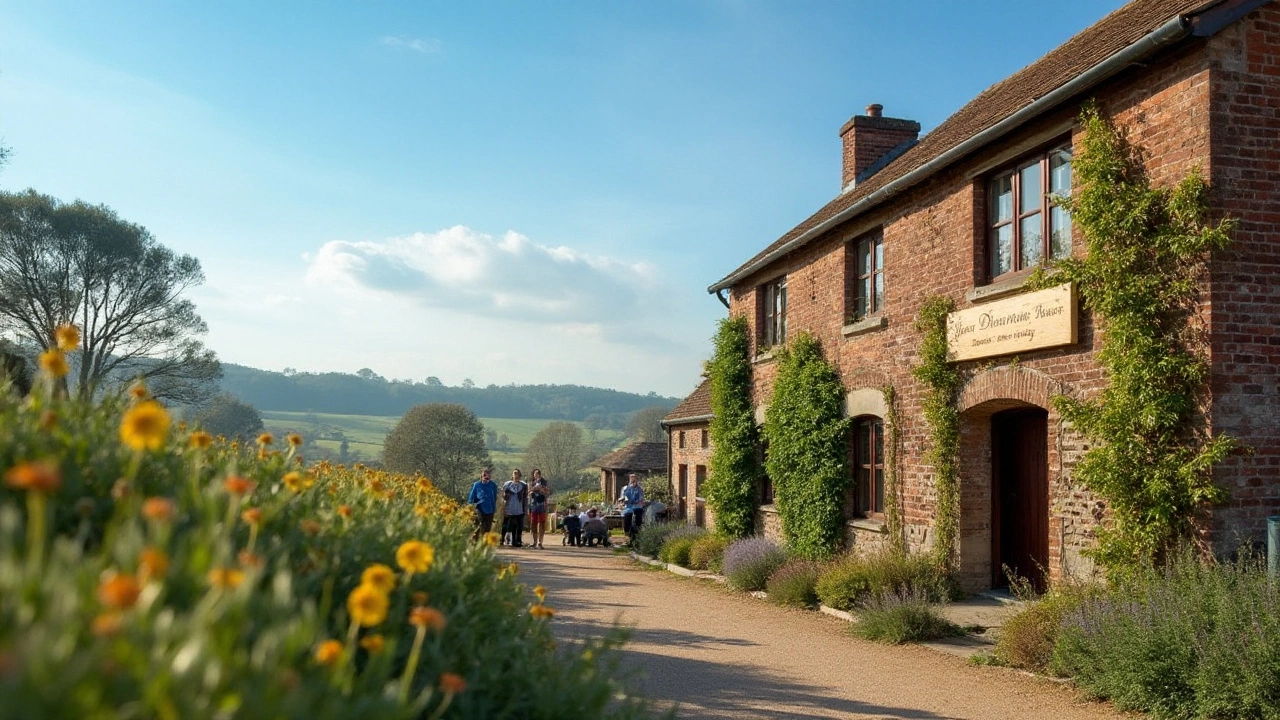The craft gin revolution is a global phenomenon that's showing no signs of slowing down. From micro-distilleries helmed by passionate artisans to expansive operations crafting well-loved classics, gin distilleries can be found in every corner of the world. The essence of each distillery varies greatly, weaving together local ingredients, traditional methods, and innovative approaches to create a spirit that's both historic and contemporary.
Whether you're a devoted gin enthusiast or a casual sipper, visiting a gin distillery can offer an insightful peek into the creative heart of gin production. It’s not just about the destination, but the stories and spirits you encounter along the way. Step inside these distilleries, and you'll discover the craftsmanship that goes into creating the distinctive flavors you love.
This journey into the world of gin offers more than just tasting – it's about understanding the blend of tradition and experimentation that makes gin an eternal favorite. Let's embark on this gin adventure, exploring what makes each distillery unique and how they contribute to the ever-growing world of gin.
- The Rise of Gin Distilleries
- Mapping Gin's Global Landscape
- Inside the Gin-Making Process
- Popular Gin Tour Destinations
- Craft Disitlleries Making Waves
- Tips for the Ultimate Gin Distillery Tour
The Rise of Gin Distilleries
In the last decade, the craft gin industry has exploded, with the number of gin distilleries rising dramatically across the globe. This boom can be traced back to a few key trends and shifts in consumer preferences. For one, there's a growing demand for artisanal and locally produced products. People are more interested than ever in knowing where their spirits come from and the stories behind them. This curiosity has fueled the growth of small, craft distilleries that emphasize creativity and local flavors over mass production.
The history of gin dates back to the Middle Ages, but it wasn't until the craft movement caught on in recent years that we saw such a significant expansion in gin production. Traditional methods have been revived and adapted by a new generation of distillers looking to put their stamp on the industry. This trend coincides with a broader renaissance in cocktail culture, where adventurous drinkers explore complex flavors and curated experiences. The beauty of the gin world lies in its versatility; the spirit's flavor profiles can be influenced immensely by the choice of botanicals, making each distillery's offerings unique.
The craft gin scene has introduced a sense of personal connection to the spirits world, reminiscent of the craft beer revolution. Emphasizing small batches and unique ingredients, these distilleries prioritize quality over quantity, and it hasn't gone unnoticed by gin enthusiasts.
Many cities and regions now host their own gin festivals, celebrating the innovation and diversity within the industry. London, naturally, has maintained its historical position as a gin hub, but locations like Portland, Oregon, and Melbourne, Australia, have become noteworthy players featuring a multitude of distilleries. These festivals often showcase emerging distilleries alongside established ones, offering a platform for producers to connect directly with their audience and share their stories.
The innovation within craft gin distilleries is not just limited to flavors. The production process itself is seeing exciting advancements. Producers experiment with unique distillation techniques, such as vapor infusion and cold-compounding, allowing for unprecedented variations in taste and aroma. Sustainable production practices are also gaining traction, with distilleries focusing on reducing waste, sourcing local botanicals, and employing eco-friendly bottling methods.
An unexpected boost also came from the COVID-19 pandemic, during which distilleries pivoted to producing hand sanitizers, gaining public goodwill, and finding new ways to engage with their communities. The adaptations during this time underscored the resilience and resourcefulness inherent in the industry.
Looking at numbers, the UK alone boasts over 800 gin distilleries, a rise from just 190 in 2015. This exponential growth is mirrored across other countries like the US and Australia. With consumers keenly interested in boutique spirits, these numbers are set to increase. The rise of gin distilleries is a testament to the global movement toward craftsmanship and authenticity, exposing drinkers to the wide-ranging spectrum of what gin can offer.
Mapping Gin's Global Landscape
The world of gin distilleries is as diverse as it is expansive. With a history rooted in Europe, gin has proliferated to become a truly global spirit. The sheer number of gin producers tells a fascinating story of cultural adaptation and innovation. In the UK alone, home to the iconic London Dry Gin, the number of distilleries has skyrocketed. In 2010, there were fewer than 200, but by 2023, that number has risen to over 600, marking a golden era for gin in the region. Meanwhile, across the Atlantic, the United States has embraced the gin renaissance with fervor. From New York’s urban distilleries producing small-batch wonders to California's sun-drenched estates crafting botanically rich spirits, the American gin scene is thriving.
Europe continues to spearhead gin's evolution, with countries like Spain and Germany developing distinctive profiles that cater to local tastes. Spain, in particular, demonstrates a unique love affair with gin, consuming vast quantities, often in the form of a refreshing gin-tonic. Elsewhere, Australia has firmly positioned itself on the world map with award-winning gins from both well-known and boutique distilleries. The local emphasis on indigenous botanicals such as pepperberry and eucalyptus adds a distinctively Australian character to their gins.
Asia is not far behind, sourcing an eclectic mix of famous and rare botanicals, which gives a regional flair to gin styles emerging from Japan, India, and beyond. The blend of tradition and modernity is especially evident in Japanese brands, which artfully balance timeless techniques with esoteric ingredients like cherry blossoms and yuzu. India's scene is also burgeoning, dovetailing traditional herbs and spices into their gin recipes. It is said, "Gin mirrors the identity and soul of the place it comes from," encapsulating its ability to absorb and reflect local cultures.
A snapshot of gin's evolving landscape wouldn't be complete without mentioning African countries, where gin is being interpreted through unique lenses. South Africa, in particular, boasts a rich tapestry of distilleries incorporating botanicals such as fynbos to produce distinctive local gins. Let’s not forget about experimental gin styles found in South America, where distillers experiment with native flora to produce small-batch, flavor-forward expressions. This global spread of gin production is a testament to the universal appeal of this adaptable spirit.
In recent times, the demand for craft gin tours has shaped many distilleries' approach, providing immersive experiences that cater to enthusiasts and novices alike. Many distilleries have realized the importance of a well-curated visitor experience, offering hands-on distillation sessions and tours that provide insight into the intricate process of gin making. Whether it's in historic gin capitals or burgeoning new markets, the global landscape of gin offers an exciting array of flavors, stories, and experiences waiting to be discovered.

Inside the Gin-Making Process
To truly appreciate a bottle of gin, you have to explore the magic that happens inside a gin distillery. It's not just about mixing ingredients; it's an art form. The gin-making process is a delicate balance of science and creativity. It all begins with the base spirit, which is usually derived from grains like wheat or barley, and it’s crucial that this spirit is neutral to ensure the botanicals take the stage. The process officially starts at the fermentation stage, where sugars are converted into alcohol. This is often approached with exacting precision, as any deviation in temperature or ingredient ratio can alter the final product.
Once the base spirit is ready, it’s time to distill. This is arguably the heart of gin production. Distillers infuse the spirit with botanicals—these are the ingredients that give each gin its distinctive flavor profile. Juniper berries are the star of any gin, but distillers often add a host of other botanicals like coriander, angelica root, citrus peels, and even unexpected additions like lavender or peppercorns. Some distillers use up to 30 botanicals! These botanicals can be distilled in two primary ways: through the steeping method, where they are soaked in the spirit before distillation, or through vapor infusion, where the vapors pass through a basket containing the botanicals, capturing their essence in a more subtle manner.
Choosing which botanicals to use is both an art and science requiring a deep understanding of how flavors interact when heated and cooled. A respected Master Distiller once said,
"Crafting gin is like composing a symphony; each note has to blend seamlessly to create harmony."After the distillation, the gin is diluted to bottling strength, usually around 40% ABV. The final crucial step is the resting period known as maturation, although not as lengthy as whiskey or wine, this time allows flavors to meld together harmoniously.
Innovative distilleries are consistently pushing boundaries and embracing modern technology, sometimes incorporating unique regional ingredients into the distillation process. Many craft gin producers are passionate about sustainability, sourcing botanicals ethically, and minimizing waste wherever possible. Some progressive distilleries have even opted for solar-powered stills to reduce their carbon footprint. The craft of making gin is as varied as the places it hails from, drawing global influences that contribute to its vast flavor palette. With over 6,000 brands of gin worldwide as of late 2023, each distillery's unique approach makes the craft exciting and ever-evolving.
Popular Gin Tour Destinations
Embarking on a journey through popular gin distilleries can be an unforgettable experience for any gin enthusiast. Among the international hotspots that beckon with their spirited allure, the United Kingdom naturally stands at the forefront. Often hailed as the birthplace of gin, London is home to some time-honored establishments such as Beefeater and Sipsmith, where heritage and innovation blend seamlessly. Each sip reveals the city’s deeply-rooted gin culture, encapsulating centuries of craftsmanship.
Crossing the channel to mainland Europe, one cannot overlook the subtle charm of Dutch distilleries. In Amsterdam, for instance, the historical Wynand Fockink offers a glimpse into the origins of gin, locally known as genever. As visitors walk through the cobblestone streets to this distillery, they're greeted by illustrious flavors steeped in tradition. Guided tours frequently delve into the genealogical links between gin and genever, offering tastings that highlight the differences and shared lineage between these kindred spirits.
The gin scene isn't just thriving in Europe; it's steadily carving out a significant presence in unexpected locales. In Australia, boutique distilleries like Four Pillars in Healesville bring the unique botanicals of the region into the limelight. Here, visitors can appreciate experimental gin recipes that leverage native ingredients like lemon myrtle and Tasmanian pepperberry. As the Australian gin landscape continues to evolve, more distilleries are opening their doors, inviting tour-goers to experience a modern take on a classic spirit.
On the other side of the globe, the United States is experiencing its own gin renaissance. Craft gin distilleries are blossoming, with cities like Portland, Oregon standing as dynamic epicenters of creativity and quality. Distilleries such as Aviation and Rogue Spirits welcome visitors into a world of flavor innovation. These tours often include an immersive experience, delving into the distillation process while sharing the stories behind their unique blends.
South Africa, with its bold botanicals and rich heritage, is not to be outdone. The Cape Town area, in particular, is a captivating destination for those seeking unique gin experiences. Distilleries here often create gins that reflect the diversity of local flora, incorporating indigenous ingredients like rooibos and fynbos. Visiting these distilleries offers a sensory journey that celebrates both the landscape and culture of the region.
A visit to these gin tours provides much more than just a tasting; it's an open door into the artistry, tradition, and innovation that defines the spirit. One industry expert once mused,
"Gin isn't just a drink; it's a narrative captured in a bottle, where every distillery tells its own passionate story of place and people."Engaging with these narratives allows visitors to partake in the heritage of gin, while savoring its vibrant and eclectic flavors across the globe.

Craft Distilleries Making Waves
Across the globe, gin craft distilleries are silently revolutionizing the way we perceive and enjoy this beloved spirit. These are not your average large-scale operations. Instead, they are often small, independent ventures led by passionate gin enthusiasts who embrace creativity and experimentation. At the heart of this movement is the desire to bring unique and locally-inspired flavors to the gin production scene. Each bottle tells a story of place and people, with ingredients often sourced straight from the distillery’s backyard or local markets. This close relationship between gin and its origins results in a dizzying array of flavors that range from earthy and herbal to fruity and floral, offering a delightful surprise with every sip.
One of the exciting elements of this wave is the sheer diversity of techniques and ingredients employed. Take, for example, the incorporation of unique botanicals. Distillers in Asia might use lemongrass or yuzu to give their gin a fresh, citrusy zing. Meanwhile, Scandinavian distillers may turn to juniper berries, mixed with wild lingonberries or birch leaves, adding a touch of wilderness. Gin tours at these craft distilleries not only offer tastings but also an opportunity to understand the painstaking process behind each bottle. It’s not just about drinking, but learning – and there’s a lot to learn from these spirited innovators.
"Craft distilleries are redefining the landscape of gin by prioritizing quality and authenticity over mass production. They are turning the gin industry on its head with bold innovation and fierce dedication to their craft." – Gin Enthusiast Magazine
Visiting such distilleries typically reveals the bold personalities and creative spirits driving innovation in gin distilleries. Many of these distillers wear multiple hats, acting as botanists, chemists, and storytellers. Their willingness to experiment creates an atmosphere of almost electric excitement, especially as new collaborations with local craftsmen and farmers come to fruition. Whether it’s small-batch aged gin matured in local oak barrels or an experimental cacao-flavored gin, the possibilities are endless and thrilling.
An illustrative example is the surge of eco-friendly craft distilleries that focus on sustainability and eco-conscious practices. Some distilleries utilize closed-loop systems to minimize waste, while others engage in community-oriented projects, such as planting trees or supporting local farmers. The commitment to a sustainable future not only sets a positive precedent for the industry but also attracts like-minded consumers who are increasingly invested in where their drinks come from and how they are made. These are key ingredients in crafting not just a gin that’s flavorful, but a revolution that is socially and environmentally conscious.
As the demand for high-quality, artisanal spirits continues to rise, these craft distilleries find themselves at the forefront of a flavorful rebellion. They are the vivacious underdogs challenging the norm, inviting drinkers to join them in redefining what gin is and can be. The next time you pour yourself a glass, take a moment to appreciate the vibrant scene that makes it possible. And when given a chance, embark on your own gin tours – each visit will be a new chapter in the age-old story of gin, written by the hands of those who dare to dream and distill.
Tips for the Ultimate Gin Distillery Tour
Embarking on a gin distillery tour can be one of the most enriching and enjoyable experiences for any spirit enthusiast. To make the most out of this exploration, it's essential to plan your visit thoughtfully. Begin by researching the many distilleries available, as options can vary from iconic producers to lesser-known local gems. Each distillery offers unique insights into the history, techniques, and creative flair that imbibe their gin production. A well-planned tour allows you to immerse yourself into the narrative of gin, enhancing your appreciation for the craft and culture surrounding this beloved spirit.
As you prepare for the tour, consider arranging visits to both craft and mainstream distilleries to appreciate the breadth of innovation within the industry. Craft distilleries often focus on small-batch production and experimentation with local botanicals, giving you a chance to taste one-of-a-kind flavors. Meanwhile, larger operations provide a glimpse into the scale and consistency required to maintain long-held reputations. Having a balance between these experiences ensures a comprehensive understanding of the modern gin landscape.
It's also wise to check each distillery's tour offerings in advance, as they can range from standard walk-throughs to interactive workshops. Some establishments even host blending or tasting sessions, allowing guests to engage directly with the spirit's creation. These interactive tours are exceptional ways to deepen your understanding and appreciation of gin, crafting a more personal connection with what you savor. Booking such experiences can enrich your tour, making it not only educational but also deeply engaging and memorable.
Don't forget to inquire about any safety guidelines or dress codes that may be in place. Many distilleries, especially the smaller or more specialized ones, have strict protocols designed to maintain the purity and safety of their production areas. Comfortable shoes and clothing are advisable, as tours often involve standing or walking for extended periods. Ensuring you're prepared will allow you to enjoy every moment without distraction. Equally, a polite inquiry about photography rules is beneficial, as not every distillery permits photos in all areas.
When visiting a gin distillery, take the opportunity to interact with the people behind the scenes – be it the master distiller, the tour guide, or the staff. They bring a wealth of stories, insights, and passion for gin that adds immense value to your tour. A quote from renowned gin expert Jared Brown states, "Understanding the 'why' behind a gin's flavor profile transforms a simple tasting into an exploration of tradition and innovation." Engaging with these experts can unearth fascinating tales of historic recipes, local influences, and contemporary trends shaping the world of gin.
Finally, remember to savor the experience itself. Every sip, every scent, and every story leaves an indelible mark on your knowledge and enjoyment of gin. Whether you're a seasoned connoisseur or new to the world of gin, these tours can kindle a deeper love and respect for this versatile spirit. After all, a gin distillery tour isn't just about tasting; it's about living the essence of gin.


